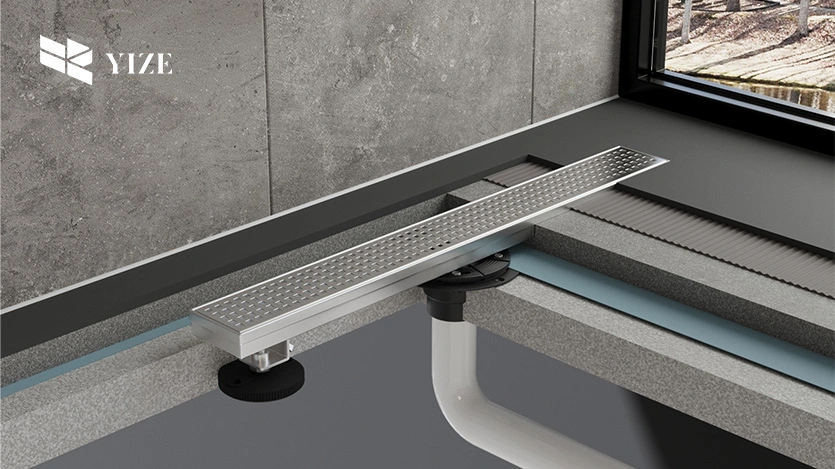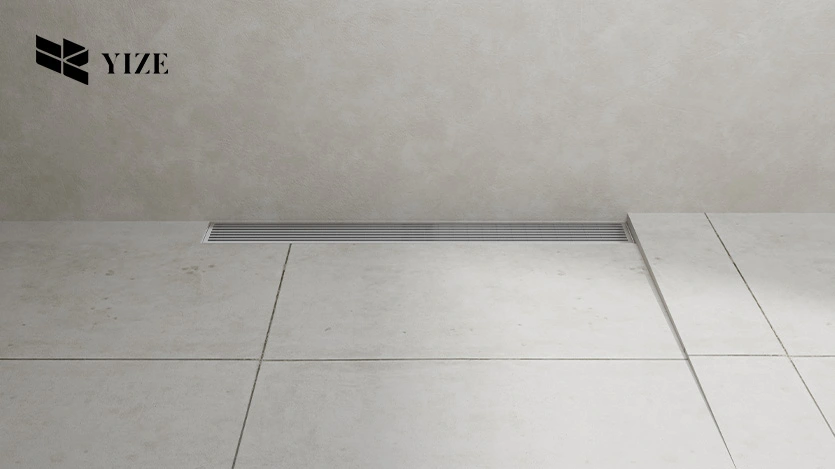
I. Introduction
Floor adjustable linear shower drain are fairly common nowadays mostly in contemporary bathroom designs. Currently, there is one more important factor that makes them preferred by many homeowners and builders, their slim profile, effective water circulation, and simple maintenance. However, putting a linear shower drain in your home or business is more than selecting a beautiful grate or cover. It is advisable to have the right parts to avoid water blocking and develop good drainage systems. Flange is one of the significant parts of the installation process for pipes.
Of great significance is the flange which helps provide a proper watertight closure between the drain as well as the subfloor. This helps avoid leakages at various intervals and as well making sure it works for longer times. In this article, issues concerning the necessity of having a flange for the linear shower drain, the role it plays and its position in the drainage system will be discussed. We will also introduce our solutions from YZDRAIN such as the products that come with flanges for easy fixing on onesides.
II. Understanding Linear Shower Drains
1. What is a Linear Shower Drain?
A linear shower drain is a long, slim drain which is best used when installing the drain on one side of the shower. Unlike ordinary point drains through which water forms along center and then is collected, linear drains enable water to run freely across the floor’s surface up to the drain. This type of drain is especially suitable for the so-called barrier-free or curbless showers, i.e. showers where the floor has a minimal pitch towards the drain. Linear shower drains offer some of the best looks and are thus commonly incorporated in new-generation bathrooms.
Benefits of linear shower drains include:
●Enhanced water flow: Water runs directly to the drain without stagnation, draining very fast.
●Modern aesthetics: Their simple design suits them for modern, sleek tile-styled bathrooms.
●Easy maintenance: Compared to conventional drains, the long, open kind is more manageable and easier to manage since they do not trap dirt.
2. Components of a Linear Shower Drain System
A linear shower drain system consists of several key components:
●Drain body: It is that part of the shower base through which water is directed towards the pipes using slants.
●Grate or cover: This is the fouled and shaped part of the drain, which has numerous models and colors and contributes to the bathroom’s appearance.
●Flange: The flange is an important attachment that seals the connection between the drain and the subfloor. This stops water from penetrating the subfloor, which, if allowed, can cause great damage over time.
All these parts have their function, and when they are produced incorrectly, expect poor drainage or even water damage.
III. What is a Flange?
A flange is a flat circular ring of metal or plastic which, when fitted around the shower drain aperture and bolted to the subfloor, provides a watertight seal. In plumbing systems, flanges are used to avoid leakage at the junctions of pipes, drainages or other fittings that join different surfaces. If not fitted and assembled properly a shower drain flange prevents water from percolating through the shower floor and causing possible mold, rot or any other form of structural damage.
The function of a flange is to ensure that water does not Escape from the drainage system. If there is no proper flange, then water can sometimes leak though the small spaces between the drain and the floor, only to be invisible.
Different Types of Flanges
There are several types of flanges used in plumbing systems, including:
●Slip-on flanges: These are the most popular and are slipped over the pipe and then either sold or glued on.
●Weld neck flanges: These are attached directly to the pipe and thus provide a good and very strong connection.
●Threaded flanges: These are normally threaded internally to connect with the pipe by screwing.
When it comes to linear shower drain installation, slip-on flanges are favored because they can fit over the drain pipe tightly without requiring additional work to achieve a leak-proof fit.
IV. What is the Main Function of a Flange in a Shower Drain System?

The flange serves two main functions in a shower drain system:
●Ensuring Proper Water Sealing: A flange will provide a leak-proof joint between a drain and the subfloor to eliminate penetration of the floor framework by water. This is especially important where there is frequent exposure to water- for example in areas like showers- one drop of water allowed to drip through the wall can cause a lot of damage over time.
●Stability and Support: The flange is valuable in that it fixes the drain and its position in the system so that the connections are tight and secure. This support is especially important in that will be receiving regular and direct pressure from both water and weight during shower usage, the drain would otherwise become loose on the floor.
V. Do You Need a Flange for Your Linear Shower Drain?
1. Situations Where a Flange is Essential
There are certain situations where a flange is absolutely necessary for the proper installation of a linear shower drain:
●Wooden subfloors: If your shower is built over a wooden base floor, a flange must be installed to ensure that water does not drip through the base, causing rotting and loss of structure.
●High water exposure areas: When there is a lot of Water flow or the shower is frequently used, a flange ensures that there won’t be any probability of leakage in a moist area.
2. Situations Where a Flange May Not Be Necessary
In some cases, a flange may not be required:
●Modern linear drains: Some modern linear drains feature a built-in waterproofing system and hence do not require a flange. This has benefits, as such systems do not have a flange, although they may have rubber gaskets and other sealing that make the connection to a water system leak-proof.
●Alternative sealing methods: In some installations, it becomes possible to use high-tech waterproof membranes or adhesive sealants, which results in watertight joints and thereby makes the flange unnecessary.
VI. YZDRAIN’s Linear Shower Drain Solutions
1. YZDRAIN’s Product Range
Academic Linear Shower Drain from YZDRAIN is a series of linear shower drains made of stainless steel or aluminium with integrated flanges. These products are intended to guarantee the watertight standards of the installation process and reduce leakage. With flanges set in drain products, there is no need for other sealing parts, so people who want to install drains by themselves or plumbing workers could purchase YZDRAIN’s products.
2. Why Choose YZDRAIN for Your Shower Drain Needs?
●Superior quality: Another strength of the products produced by YZDRAIN, is that they are manufactured with long-lasting material that can be used for quite a long time.
●Innovative design: Fewer parts make their linear drains easier to install and provide better water sealing.
●Customer support: YZDRAIN has a client care team to ensure they offer you the right drain to suit your installations best.
VII. Installation Tips for Linear Shower Drains with Flanges

When installing a adjustable linear shower drain with a flange, follow these tips:
●Ensure the flange is in the right place and tight to the subfloor so it does not leak.
●Employ an unreinforced waterproof membrane in order to improve the integrity of the watertight joint.
●Refreez for any missing links or loopholes which may cause future leakage on the installation side.
VIII. Conclusion
A flange is very useful for adjustable linear shower drain, especially when they are laid on wooden subfloors or in locations that are often exposed to water. Although modern producers supply linear drains with integrated waterproofing layers, which do not necessarily involve a flange, you should consider your situation. YZDRAIN is a linear shower drain with a flange that helps complete the installation process and ensure the shower is watertight.
Frequently Asked Questions (FAQs)
1. How high should shower drain flange be?
The top of the Pipe should be no higher than, and no more than 1/8″ lower than, the top surface of the floor on which the base will be set. Hand-tighten Drain Nut, and then tighten the rest of the way (about 1/2 turn) with a wrench.
2. What does a shower flange do?
The flange is a type of connector that is used to connect different types of parts in plumbing systems. In the shower pan world it is often used to describe the drain itself, which leads to some confusion. So here goes a bit of clarity to what the pieces of the drain are. The drain as a whole is called the drain body.
3. What is a flange in a shower drain?
A shower drain flange is a seal that prevents water from leaking from a shower drain. It’s a key part of a shower’s drainage system and is usually made of ABS material.

